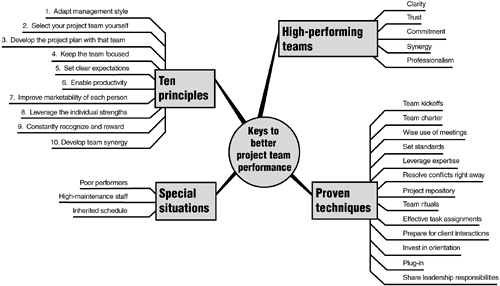Special Situations
There are going to be project situations where you won't have a stellar, high-performing team. There may be times where you have just the opposite situation to deal with. In either case, you still need to get the work done. It's in these situations where your goal is to get "better" team performance. While we could spend an entire chapter on all the problem situations you may encounter, I at least want to spend a section looking at some special situations related to project team performance that you are likely to encounter and offer a few helpful recommendations in each case.
- Poor performers Poor performers generally fall into two categories: unacceptable work results or unacceptable behaviors. In many cases, the poor performance is a result of unclear expectations. If faced with this situation, keep these action items in mind:
tip

Performance feedback should be timely, discreet, and specific.
- Verify expectations On first occurrences, don't overreactverify the expectations that they had and take responsibility for any lack of clarity.
- Provide feedback After you have proper information, provide specific feedback to the team member as soon as possible in a private setting. Focus on the behavior or result, not the person.
- Enable success Do everything that you can do to enable each team member's success. Provide resources. Knock down obstacles. Provide every opportunity for their performance to improve.
- Initiate backup plans At the same time, you cannot assume their performance will get better. At the first signs of performance issues, start thinking about what you can do to mitigate the impact to the project, if you do need to replace the team member or if the performance does not improve.

Keep in mind: The rest of team is watching how you deal with these situations. Your challenge is to strike the balance between handling the person fairly and not letting the poor performance become a drag on the team.
- Cut your losses Assuming you've done everything we've mentioned so far, there comes a time when you've got to cut your losses. The main reason why a poor performer needs to be removed is the effect it can have on the performance and morale of the rest of the team.
- High-maintenance staff This group of team members includes those individuals who have a reputation of either being difficult to work with or possessing unusual personalities. In most cases, these are the people you need for your key critical path tasksof course. From experience, here are my two key recommendations for these situations:
- Check for yourself Don't assume the reputation (the perception) is totally true. Verify for yourself. I have found that in many cases, these individuals are unfairly labeled. These labels often say more about the people who are uncomfortable working with individuals who are different from them than anything else.
- Treat them the same Use the same approach with them as you would any other team member. Work to understand their motivators, clarify expectations, avoid surprises, and help them to be successful.
- Schedule developed without team I know we emphasize the importance and the value in developing the detail project plan and schedule with the team. I also realize this does not always occur in the real-world (shocking I know). If you find yourself in a situation where either you or your team is asked to take responsibility for a schedule that they did not help develop, you must take the time to review the schedule. You need to get a buy-in from the team members before continuing. Two important items for consideration here:
- Understand the schedule assumptions In many of these situations, team members totally dismiss the merits of a schedule because they are not aware of the assumptions that serve as the foundation for the schedule. Key assumptions include those about resource ability and quality level of work product (completion criteria).
- Identify risks If there are gaps between the schedule assumptions and project reality, or if you cannot get commitment from the team, you have some new project risks if not outright issues. Follow your designated risk and issue management procedures to handle it.
Part i. Project Management Jumpstart
Project Management Overview
- Project Management Overview
- What Is Project Management…Exactly?
- What Is the Value of Project Management?
- Why Are Projects Challenging?
- Growing Demand for Effective Project Managers?
- Trends in Project Management
The Project Manager
- The Project Manager
- One Title, Many Roles
- Key Skills of Project Managers
- Qualities of Successful Project Managers
- 15 Common Mistakes of Project Managers
Essential Elements for any Successful Project
- Essential Elements for any Successful Project
- What Exactly Is a "Successful" Project?
- Learning from Troubled Projects
- Learning from Successful Projects
- Essential Project Manager Toolkit
Part ii. Project Planning
Defining a Project
- Defining a Project
- Setting the Stage for Success
- How Does Defining a Project Relate to Project Planning?
- Project Definition Document
- Project Definition Checklist
Planning a Project
- Planning a Project
- Key Project Planning Principles
- Important Questions Project Planning Should Answer
- Building a Project Plan
- Summary of Supplemental Project Plan Components
- Project Plan Checklist
Developing the Work Breakdown Structure
- Developing the Work Breakdown Structure
- What Is a WBS Exactly?
- Why Is the WBS Important?
- The Process of Building a WBS
Estimating the Work
- Estimating the Work
- Next Step in the Schedule Development Process
- Managing the Risk, Managing the Estimates
- Reasons for Estimating Woes
- Powerful Estimating Techniques and Methods
- Best Practices
Developing the Project Schedule
- Developing the Project Schedule
- The Impact of the Project Schedule
- The Goal of the Schedule Development Process
- Key Inputs for Building a Schedule
- Creating a Schedule
Determining the Project Budget
- Determining the Project Budget
- The Impact of the Project Budget
- Principles of an Effective Budget
- Creating a Project Budget
- Common Budget Challenges
Part iii. Project Control
Controlling a Project
- Controlling a Project
- What Is Project Control?
- Management Fundamentals for Project Control
- Powerful Techniques for Project Control
- Performance Reporting
- Variance Responses
- Leveraging Earned Value Management Concepts
- Common Project Control Challenges
- Lessons from Project Recoveries
Managing Project Changes
- Managing Project Changes
- What Exactly Is a Project Change and Whats the Big Deal Anyway?
- Fundamentals for Managing Project Change
- What Causes Unplanned Scope Changes?
- Essential Elements of a Project Change Control System
- Powerful Techniques for Minimizing Project Changes
- Common Project Change Control Challenges
Managing Project Deliverables
- Managing Project Deliverables
- "Managing Project Deliverables" Means What Exactly?
- Why Do This? Its Too Much Work
- Identify, Protect, and Track: The Principles of Managing Work Products
- Best Practices
- Configuration Management Plan
- Common Challenges and Pitfalls
Managing Project Issues
- Managing Project Issues
- The Goals, Objectives, and Principles of Project Issue Management
- Key Features of Issue Management System
- Options for Issue Log
- Best Practices
- Some Special Situations
Managing Project Risks
- Managing Project Risks
- Key Risk Management Principles
- The Essential Process for Managing Project Risks
- The Common Sources of Project Risk
- Typical Problems
- Powerful Risk Control Strategies
- Are You Sure Its a Risk?
Managing Project Quality
- Managing Project Quality
- What Is "Project Quality"?
- Unique Aspects of Managing Project Quality
- Principles of Managing Project Quality
- Powerful Tools and Techniques for Project Quality
- Powerful Quality Strategies
- Typical Quality-Related Challenges
Part iv. Project Execution
Leading a Project
- Leading a Project
- More Than Managing
- Where Is Leadership Needed on a Project?
- Twelve Keys to Better Project Leadership
- Power of Servant Leadership Approach
Managing Project Communications
- Managing Project Communications
- What Are Project Communications?
- The Importance of Project Communications
- Why Communicating Can Be Tough
- Seven Powerful Principles
- Best Practices of Effective Project Communicators
Managing Expectations
- Managing Expectations
- Value of Reviewing Stakeholder Expectation Management
- Critical Aspects of Expectations
- Seven Master Principles of Expectation Management
- Essential Elements of Managing Expectations
Keys to Better Project Team Performance
- Keys to Better Project Team Performance
- High-Performing Teams
- Ten Key Principles
- Proven Techniques
- Special Situations
Managing Differences
- Managing Differences
- Five Key Principles
- Proven Techniques for Leading Cross-Functional Projects
- Proven Techniques for Leading Cross-Cultural Projects
- Proven Techniques for Leading Virtual Projects
Managing Vendors
- Managing Vendors
- First, Lets Clarify a Few Terms
- Ten Proven Principles of Vendor Management
- Twelve Tips for Buyers
- Seven Tips for Sellers
- Twelve Key Project Management Skills for Better Vendor Management
- Stuff You Need to Know About Contracts
Ending a Project
EAN: N/A
Pages: 169

